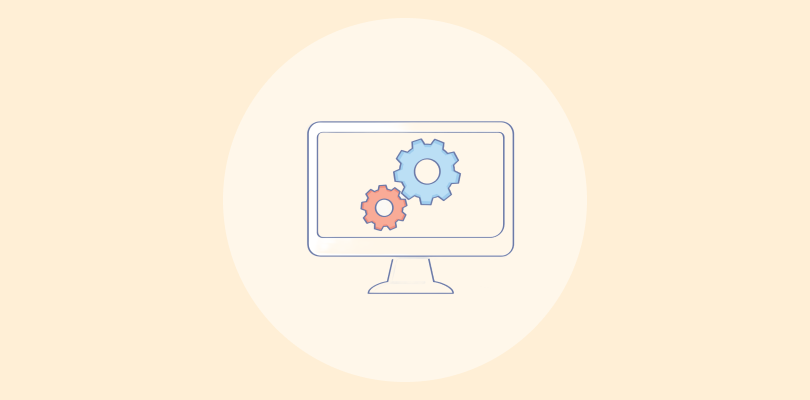Email management can soon turn into a headache when you have an overflowing inbox.
Thanks to email automation software, I can automatically assign emails to team members, share automated responses, and organize my inbox with labels and statuses.
Whether you are a sales, customer service, or marketing professional, I have listed the top 5 email automation platforms to help you reach inbox zero faster.
| Email Automation Software | Best for | Pricing |
|---|---|---|
| ProProfs Help Desk | Email Automation & Support Ticketing for Customer Delight | FREE for a single user. Plans start at $19.99/user/month. |
| Zendesk Sell | Sales Emails | Starts at $19/user/month |
| HubSpot | HubSpot Users | Starts at $15/user/month |
| Hiver | Gmail-Based Help Desk | Starts at $15/user/month |
| HelpScout | Customer Conversations & Unified Platform | Starts at $20/user/month |
What Is Email Automation Software?
Email automation software is a powerful tool designed to help businesses efficiently handle large volumes of email communications. This type of software automates the organization, prioritization, and response to incoming emails, significantly improving response times and enhancing customer service.
Some email automation tools can also help you send bulk outreach, track email marketing campaigns, and boost lead generation. These tools often include analytics functionalities that track key metrics like volume trends, response times, and customer satisfaction levels.
Top 5 Email Automation Software to Consider for Your Team
In this section, I will share each tool’s comprehensive features, pros and cons, and pricing details to help you make a fair decision.
Most of the tools have been a part of my team’s email automation strategy, while some were recommended by peers and industry experts. Let’s discuss this in detail.
1. ProProfs Help Desk – Best for Email Automation & Support Ticketing for Customer Delight
ProProfs Help Desk helps us manage all our team email accounts like a pro! Thanks to its shared inbox feature, multiple people can access accounts like support@, info@, returns@, etc., simultaneously and respond to customers from one place.
I really appreciate the email automation features that ProProfs brings to the table. For instance, we can use canned responses to share one-click replies to common queries. Similarly, other features like automated notifications and feedback surveys are equally impressive.
I suggest you also use this tool to create an online knowledge base, which includes FAQs, guides, and video tutorials. This will help you reduce the number of unnecessary emails from customers.
Also, I’m sure you will find the reports and analytics quite easy to scan. You can generate reports to track email performance using metrics like average response times, CSAT scores, and more.
What you’ll like:
- Custom email signatures to send professional-looking emails to customers.
- AI-powered chatbots to assist customers even when your team is offline.
- Internal notes can be added to emails to facilitate internal discussions and boost team collaboration.
- IP restrictions enhance data security, restricting the access of your account to specific IP addresses only.
What you might not like:
- Frequent updates and feature releases can be overwhelming for some users.
- The free plan is limited to a single agent only.
Pricing:
- FREE for a single user. Plans start at $19.99/user/month for 2 or more users. No hidden fees. A 15-day money-back guarantee.
2. Zendesk Sell – Best for Sales Emails
I’ve been using Zendesk Sell to streamline our sales communications, and it’s remarkable how it simplifies managing sales emails.
The software integrates seamlessly with our sales workflow, providing tools that help prioritize and respond to important client emails efficiently.
It features email tracking, automated sequences, and performance reporting, making follow-ups precise and timely. The insights from the analytics dashboard have been crucial in shaping our sales strategies.
On the downside, even though Zendesk is a popular software brand in the market, it can be quite expensive. High-pricing plans make it an unsuitable option for startups or small businesses on a budget.
What you’ll like:
- Automated email sequences save time and keep engagement high.
- Real-time notifications when emails are opened or clicked.
- Detailed analytics aid in refining sales tactics.
- Seamless integration with CRM functionalities.
What you might not like:
- Zendesk Sell can be quite expensive, making it unsuitable for smaller teams.
- There is a learning curve for utilizing advanced features.
Pricing:
- Starts at $19/user/month
3. HubSpot – Best for HubSpot Users
Using HubSpot for email management can be a game-changer, especially if you’re already using other HubSpot offerings.
Its email marketing tool integrates perfectly with the CRM, ensuring that all interactions are logged and tracked without effort. Personalization and automation features make it easy to create tailored campaigns that resonate with your audience, boosting engagement rates significantly.
Also, you can create stunning emails effortlessly without any need for coding. Subsequently, configure triggers, conditions, and actions to ensure the correct emails are delivered to the appropriate leads exactly when needed.
What you’ll like:
- Deep integration with HubSpot CRM enhances user experience.
- Powerful automation capabilities streamline campaign management.
- Extensive personalization options improve engagement.
- Comprehensive reporting tools provide valuable insights.
What you might not like:
- Mostly beneficial for existing HubSpot ecosystem users.
- Can get expensive as you scale up.
Pricing:
- Starts at $15/user/month
4. Hiver – Best for Gmail-Based Help Desk
Do you use Gmail to manage your customer service emails? If, yes, Hiver can help you and your team achieve more without leaving your Gmail inbox.
While using Hiver for more than six months, it transformed our support team’s efficiency by turning our familiar Gmail inbox into a powerful help desk. This meant that we could handle emails and live chat under one roof.
Features like shared inboxes, email templates, and automation rules reduced our response times and improved overall customer service quality.
On the downside, Hiver is solely designed for Gmail users. If you use a different email client, this tool does not have anything to offer.
What you’ll like:
- Seamless integration with Gmail, enabling a simple interface.
- Shared inboxes improve collaboration among team members.
- Automation rules for sorting and prioritizing emails.
- Analytics provide insights into team performance and email volume.
What you might not like:
- Limited to Gmail users, not suitable for other email clients.
- Some advanced features may require a steep learning curve.
Pricing:
- Starts at $15/user/month
5. HelpScout – Best for Customer Conversations & Unified Platform
HelpScout is another automated email software that you can use for managing your customer conversations across multiple channels, including email.
Its unified platform not only makes it easy to track all customer interactions but also provides context-rich profiles to help better understand and respond to customers. The integration of features like knowledge base and chat within the same tool can enhance your support capabilities and efficiency.
I’m sure, you will love its intuitive app for Android and iOS platforms. You can use the app to check the email queue, collaborate with team members, and monitor response times.
What you’ll like:
- Unified platform centralizes communications.
- Context-rich customer profiles aid in personalized service.
- Includes a built-in knowledge base and chat for comprehensive support.
- Intuitive interface and easy navigation.
What you might not like:
- Primarily focused on small to medium-sized businesses.
- Customizations and integrations can be limited compared to larger platforms.
Pricing:
- Starts at $20/user/month
Evaluation & Selection Criteria
The evaluation of products or tools chosen for this article follows an unbiased, systematic approach that ensures a fair, insightful, and well-rounded review. This method employs six key factors:
- User Reviews/Ratings: Direct user experiences, including ratings and feedback from reputable sites, provide a ground-level perspective. This feedback is critical in understanding overall satisfaction and potential problems.
- Essential Features & Functionality: The value of a product is ascertained by its core features and overall functionality. Through an in-depth exploration of these aspects, the practical usefulness and effectiveness of the tools are carefully evaluated.
- Ease of Use: The user-friendliness of a product or service is assessed, focusing on the design, interface, and navigation. This ensures a positive experience for users of all levels of expertise.
- Customer Support: The quality of customer support is examined, considering its efficiency and how well it supports users in different phases – setting up, addressing concerns, and resolving operational issues.
- Value for Money: Value for money is evaluated by comparing the quality, performance, and features. The goal is to help the reader understand whether they would be getting their money’s worth.
- Personal Experience/Expert’s Opinion or Favorites: This part of the evaluation criteria draws insightful observations from the writer’s personal experience and the opinions of industry experts.
Which Is the Best Email Automation Software?
Email automation software revolutionizes the way businesses interact with their customers by streamlining communication processes and ensuring timely and relevant engagement.
By automating routine email management tasks, businesses can focus on crafting personalized and impactful messages that enhance customer relationships, improve response rates, and drive conversions.
If you ask me, I think ProProfs Help Desk can be the best email automation solution for your growing team. Features such as canned responses, automated email routing, prioritization & labels, internal notes, etc., can help you delight customers and reach inbox zero faster. If you have further questions, feel free to explore this small FAQ section below.
Email Automation Software: FAQs
What features should I look for in email automation software?
Look for features like canned responses, advanced sorting and tagging capabilities, seamless integration with CRM systems, robust analytics for tracking performance, and customizable workflows. Scalability and user-friendly interfaces are also important to accommodate growth and ensure ease of use.
What should I consider when choosing Email Automation software?
Consider your specific needs, such as the volume of emails, the complexity of workflows, and the level of customization required. Evaluate the software's compatibility with your existing systems, its ease of use, customer support services, security features, and overall cost-effectiveness.
FREE. All Features. FOREVER!
Try our Forever FREE account with all premium features!
 We'd love your feedback!
We'd love your feedback! Thanks for your feedback!
Thanks for your feedback!







